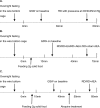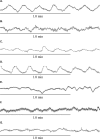Ameliorating effects of auricular electroacupuncture on rectal distention-induced gastric dysrhythmias in rats
- PMID: 25643282
- PMCID: PMC4313944
- DOI: 10.1371/journal.pone.0114226
Ameliorating effects of auricular electroacupuncture on rectal distention-induced gastric dysrhythmias in rats
Abstract
Gastric slow waves (GSW) are known to regulate gastric motility and are impaired with rectal distention (RD). Electroacupuncture (EA) at body acupoints, such as ST 36, has been shown to improve gastric dysrhythmias; however, little is known about the possible effects of auricular electroacupuncture (AEA) on GSW. To study effects and possible mechanisms of AEA on RD-induced gastric dysrhythmias in rats, ten male Sprague-Dawley (SD) rats implanted with gastric serosal electrodes were studied in two different experiments in fed state. Four sessions were performed in experiment 1 as follows: control (RD, no stimulation), RD+AEA, RD+EA at body points and RD+sham AEA. Two sessions were included in experiment 2 to study mechanisms of AEA: RD + atropine and RD + atropine + AEA. It was found that 1) RD significantly decreased the percentage of normal GSW from 89.8 ± 3.5% to 76.0 ± 3.3% (P<0.05); 2) AEA increased the percentage of normal GSW during RD to 94.0 ± 2.1% (P<0.05 vs. RD) via a reduction in the percentages of tachygastria and arrhythmia (P<0.05 vs. RD); 3) atropine blocked the ameliorating effect of AEA on RD-induced gastric dysrhythmias. Our results demonstrated that RD induces gastric dysrhythmias in fed state in rats. AEA improves RD-induced gastric dysrhythmias via the vagal pathway. AEA may have a therapeutic potential in treating gastric dysrhythmias.
Conflict of interest statement
Figures







Similar articles
-
Electroacupuncture improves impaired gastric motility and slow waves induced by rectal distension in dogs.Am J Physiol Gastrointest Liver Physiol. 2008 Sep;295(3):G614-20. doi: 10.1152/ajpgi.90322.2008. Epub 2008 Jul 24. Am J Physiol Gastrointest Liver Physiol. 2008. PMID: 18653722
-
Electroacupuncture via chronically implanted electrodes improves gastric dysmotility mediated by autonomic-cholinergic mechanisms in a rodent model of functional dyspepsia.Neurogastroenterol Motil. 2018 Oct;30(10):e13381. doi: 10.1111/nmo.13381. Epub 2018 Jun 1. Neurogastroenterol Motil. 2018. PMID: 29856090
-
Effects and mechanisms of auricular electroacupuncture on gastric hypersensitivity in a rodent model of functional dyspepsia.PLoS One. 2017 Mar 28;12(3):e0174568. doi: 10.1371/journal.pone.0174568. eCollection 2017. PLoS One. 2017. PMID: 28350818 Free PMC article.
-
Electrical neuromodulation at acupoint ST36 normalizes impaired colonic motility induced by rectal distension in dogs.Am J Physiol Gastrointest Liver Physiol. 2015 Sep 1;309(5):G368-76. doi: 10.1152/ajpgi.00467.2014. Epub 2015 Jun 25. Am J Physiol Gastrointest Liver Physiol. 2015. PMID: 26113299
-
Physiology and pathophysiology of the interstitial cells of Cajal: from bench to bedside. VI. Pathogenesis and therapeutic approaches to human gastric dysrhythmias.Am J Physiol Gastrointest Liver Physiol. 2002 Jul;283(1):G8-15. doi: 10.1152/ajpgi.00095.2002. Am J Physiol Gastrointest Liver Physiol. 2002. PMID: 12065286 Review.
Cited by
-
Auricular vagal nerve stimulation ameliorates burn-induced gastric dysmotility via sympathetic-COX-2 pathways in rats.Neurogastroenterol Motil. 2016 Jan;28(1):36-42. doi: 10.1111/nmo.12693. Epub 2015 Oct 21. Neurogastroenterol Motil. 2016. PMID: 26486522 Free PMC article.
-
Transcutaneous auricular vagal nerve stimulation improves functional dyspepsia by enhancing vagal efferent activity.Am J Physiol Gastrointest Liver Physiol. 2021 May 1;320(5):G700-G711. doi: 10.1152/ajpgi.00426.2020. Epub 2021 Feb 24. Am J Physiol Gastrointest Liver Physiol. 2021. PMID: 33624527 Free PMC article.
-
Ameliorating effects and mechanisms of transcutaneous auricular vagal nerve stimulation on abdominal pain and constipation.JCI Insight. 2021 Jul 22;6(14):e150052. doi: 10.1172/jci.insight.150052. JCI Insight. 2021. PMID: 34138761 Free PMC article. Clinical Trial.
-
The Effects of Auricular Electro-Acupuncture on Ameliorating the Dysfunction of Interstitial Cells of Cajal Networks and nNOSmRNA Expression in Antrum of STZ-Induced Diabetic Rats.PLoS One. 2016 Dec 8;11(12):e0166638. doi: 10.1371/journal.pone.0166638. eCollection 2016. PLoS One. 2016. PMID: 27930657 Free PMC article.
-
Effects of electroacupuncture on stress-induced gastric dysrhythmia and mechanisms involving autonomic and central nervous systems in functional dyspepsia.Am J Physiol Regul Integr Comp Physiol. 2020 Jul 1;319(1):R106-R113. doi: 10.1152/ajpregu.00256.2019. Epub 2020 Jun 3. Am J Physiol Regul Integr Comp Physiol. 2020. PMID: 32493036 Free PMC article.
References
-
- Wang J, Song J, Hou X, Liu J, Chen JD (2010) Effects of cutaneous gastric electrical stimulation on gastric emptying and postprandial satiety and fullness in lean and obese subjects. J Clin Gastroenterol. 44: 335–9. - PubMed
Publication types
MeSH terms
Substances
Grants and funding
LinkOut - more resources
Full Text Sources
Other Literature Sources
Medical
Miscellaneous

